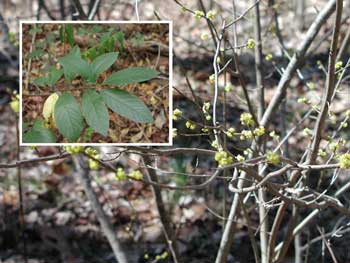Resource Library
Plant of the Week: Spicebush
The University of Arkansas System Division of Agriculture does not promote, support or recommend plants featured in "Plant of the Week." Please consult your local Extension office for plants suitable for your region.
Plant of the Week
[A-Z]
Spicebush
Latin: Lindera benzoin

Our Native American shrubs have had an enfeebled effect on the landscape world. Only a few have the large, showy flowers and evergreen leaves considered requisites to achieve garden stardom. But this outdated notion may be changing as the concept of what a garden is supposed to look like, and how it fits into the natural world, evolves. Spicebush, Lindera benzoin, is an easily overlooked native shrub that has a place in the modern garden because of its role as a companion plant for swallowtail butterflies.
Spicebush is a deciduous, multiple-stemmed twiggy shrub growing 6 to 8 feet tall that belongs to the laurel family. This species, which typically is found in moist rich bottomland sites as a part of the understory, ranges throughout the eastern deciduous forest as far north as Ontario and as far west as Texas. Three species of Lindera occur in the New World, with about 80 others described from Southern and Eastern Asia.
It has simple, entire oblong leaves 3 to 4 inches long that are light green on the upper surface and paler beneath. In sunny sites, the fall color is a clear yellow. When crushed, the leaves give off a distinctive spicy aroma. Native Americans used the bark and leaves in various combinations with other plants in herbal remedies and as a spice in cookery. For example, an allspice-like spice made from spicebush berries is recommended as the perfect seasoning for opossum and groundhog.
The tiny yellow-green, non-fragrant flowers of spicebush are produced in clusters along the bare branches and are amongst the earliest to appear in the spring, typically blooming about the same time as forsythia. Spicebush is dioecious with male and female plants, so both must be present for fruit production. The bright red berries are produced in midsummer and are favorites of a number of birds.
Spicebush is the caterpillar food source for the eastern tiger swallowtail, the spicebush swallowtail butterflies and the promethea moth. The swallowtail caterpillars are of the big-headed type, with large eye spots that supposedly help frighten off birds - and perhaps small children. The promethea moth larvae, which feeds on other plants besides spicebush, is pinkie-sized, glaucous green and with four prominent orange tubercles and black dots down its sides. While the adult butterflies do not feed directly on the spicebush, they seek out the plants for egg laying.
In the summer of 2011, we will be opening a butterfly house at the Botanical Gardens of the Ozarks. The small enclosed space will provide protection from birds and concentrate the butterflies in a small area for easier viewing. Inside, we will plant a wide array of plants that will sustain the caterpillars of the various species we hope to encourage. Many caterpillars are host-specific and will feed only on a very limited group of plants. Success will be judged by finding the plants tattered and stripped of leaves, not the clean, pest-free look many gardeners associate with good gardening practices. Adult butterflies tend to be less specific about the nectar plants on which they feed but are very choosy when it comes egg-laying time.
Spicebush is available from nurseries specializing in native plants. It transplants poorly and is best planted in the garden from container-grown plants. Because the plants may be either male or female, a grouping of three to five seed-grown specimens is recommended to ensure berry formation. Plants do best in good soil with medium shade. Once established, they will tolerate summer-dry sites. In heavy shade, spicebush plants tend to be larger and have a more open habit of growth.
By: Gerald Klingaman, retired
Retired Extension Horticulturist - Ornamentals
Extension News - February 4, 2011
The University of Arkansas System Division of Agriculture does not maintain lists of retail outlets where these plants can be purchased. Please check your local nursery or other retail outlets to ask about the availability of these plants for your growing area.